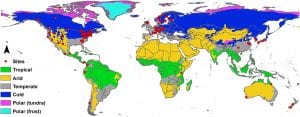Small catchments provide water to larger streams and are important sources of fresh water for ecosystems. Therefore, understanding the hydrological functioning of small catchments is essential to understand floods, droughts, and the impacts of land use or climate change on water resources.
Environmental tracers can be used to track water along its flow pathways from the input, as precipitation or snowmelt, to the output, as streamflow or plant transpiration. The stable isotopes of hydrogen and oxygen are particularly powerful as they are part of the water molecule.
Hydrograph separation is a widely applied technique that uses tracer data to quantify the contribution of different water sources (end-members) to streamflow. For its successful application, it is critical to adequately characterize these sources. However, in most small catchment studies water samples are collected from the end-members at one or a few locations. This assumes that the spatial variability is negligible and that the sampling sites are representative for the entire catchment.
In a WIREs Water study, Professor Daniele Penna of the University of Florence and Ilja van Meerveld, group leader at the University of Zurich, tested this assumption by reviewing studies that used stable isotopes to investigate hydrological processes in small catchments.

World map with all study sites included in this review (red dots). Note that some sites include multiple catchments (e.g., H.J. Andrews in USA, Krycklan in Sweden, Maimai in New Zealand, etc.). The legend refers to the Köppen‐Geiger climate classification (based on Peel, Finlayson, & McMahon, 2007).
The researchers assessed the typical spatial variability in the isotopic composition of different hydrological compartments (e.g., precipitation, snowmelt, soil water, groundwater, streamflow) when they were sampled at five or more locations across a catchment. To determine how this spatial variability might affect the isotope-based hydrograph separation results, real and synthetic data was used from a small catchment, and varied the isotopic composition of the end-members by the observed typical variability. This caused a significant change in the estimated maximum contributions of the three components compared to the reference scenario and suggests that caution is needed when interpreting hydrograph separation results if they are based on samples taken at only one or a few locations.
Above all, these results show that the assumption of negligible spatial variability may not be valid for small catchments, and that it is thus necessary to take samples from a hydrological compartment at multiple locations.

















